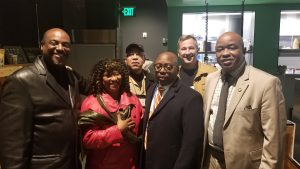Bay Area
Seeking Solutions to Crime Wave, Oakland District 3 Community Holds Safety Forum with Police, Elected Leaders
Citizens and business owners met with elected officials on Tuesday at the Calabash restaurant in Uptown Oakland to air concerns on public safety and rising crime in their district. Issues on the table included the need for faster police responses, connecting non-violent offenders with resources and an understanding of the Alameda County District Attorney’s prosecuting practices and role in the system’s matrix.

By Carla Thomas
Citizens and business owners met with elected officials on Tuesday at the Calabash restaurant in Uptown Oakland to air concerns on public safety and rising crime in their district.
Issues on the table included the need for faster police responses, connecting non-violent offenders with resources and an understanding of the Alameda County District Attorney’s prosecuting practices and role in the system’s matrix.
Area 2 Police Captain Jeff Thomason of the Oakland Police Department (OPD), Oakland District 3 Councilmember Carroll Fife, Alameda County District Attorney Pamela Price, and Harold Duffey, Interim City Administrator for the City of Oakland were present.
This month, OPD responded to over 20 commercial break-ins in a matter of days. Frequent shootings are occurring in areas of East and West Oakland, now tracked by Shot Spotter, which alerts police where shots have been fired and directs officers to the right place.
Moderated by Nathan Moon, advocacy director of the Ujima Neighborhood Council, and hosted by Angela Moore of Oakland’s Neighborhood Services Division, the consensus reached in the meeting was that the rise in city violence corresponded to the abundance of automatic weapons on the streets, the continuing historic crack epidemic, and a current uptick in fentanyl use.

Pastor Raymond Lankford, Oakland Private Industry Council, Alameda County District Attorney Pamela Price, Oakland Public Works Director Harold Duffey, Chief Assistant DA Royl L. Roberts, Pastor John Huddle, Chief Assistant DA Otis Bruce, Jr. Photo by Carla Thomas.
Victims of physical violence, car break-ins and small business break-ins with no arrests have left citizens with many questions about public safety.
With so many questions and not enough answers, citizens have further updated their demand: the ability to not just feel safe in their community but actually be safe in local surroundings.
The meeting included about 40 stakeholders, even a few beyond District 3 boundaries. Chinatown community leader Darlene Wong detailed the timeline and tools used to break into a popular restaurant on Eighth Street, one of four break-ins in the area.
According to Wong, the restaurant was empty by 3:15 a.m., and within five minutes, thieves spent the next 14 minutes using a saw, bolt cutters, and a hammer to bust through the restaurant’s gate and two double doors. Wong said the damage and theft cost $36,000 and her boss, the restaurant’s owner is livid.
Wong said cultural dynamics and fear of retaliation have prevented residents right across the street from reporting incidents.
“We have neighbors right across from our business, but fear of retaliation is big in the culture,” she said.
Wong hopes that a third-party patrol company and community liaisons will work more closely with the Chinatown Improvement Council.
Nina Moore, third-generation owner of Everett & Jones Barbeque Restaurant in Jack London Square, said their establishment had been victimized by theft twice in one week.
“They trashed the office and stole two safes,” said Moore. “It’s very stressful because my mom started this business in 1973. We are family-owned and -operated. My sister and I inherited and now run the business after our mom passed of cancer two years ago. We need more support for our businesses and public safety,” said Moore.
Price listened closely to the concerns during the meeting and explained that up until now the function of the District Attorney’s office has been the same for 100 years.
She acknowledged that lack of resources and even under-utilized resources have impacted the community and clarified that she has no authority over the OPD or how it functions, and the OPD has no authority over her.
Hiring eight new attorneys and two for mental health are the beginning of change, according to Price. “We spent the month of January reviewing cases and found 37 people in jail that are incompetent for trial,” said Price.
She also explained that mental illness is not a crime and mentally ill citizens that need an alternative should have been referred or sent to the Care and Navigation Center (CNC).
With two years of a three-year contract and a $300,000 annual budget, Price says the center has only served six people. “With no oversight and accountability under the previous administration, we end up with people in need of medical care or in need of a time of respite at the CNC, sent to jail and forgotten.”
Price also explained many are reluctant to be transported to a care center in the back of a police car.
Until a few weeks ago there was only one mental health liaison for the entire county. Price said. “There are many systemic changes we are currently working on. I just increased my staff to support those with mental health issues.”
Plans to work closely with community-based organizations in a full-service partnership with the Alameda County Behavioral Health Department and the Sheriff’s Department are underway, Price said.
Shared data, interdepartmental communications, and the use of collateral courts for qualifying defendants are also changes she’s making.
“We interact with 19 agencies. We can’t prosecute unless a case is referred to the D.A. To date, there was no data on referrals, public or private. There has been no public transparency or internal accountability. We’re working with I.T. on a data system to track everything.”
Pastor Lankford of the Oakland Private Industry Council and his team of citizen patrollers offered alternatives to police intervention. “When members of and from the community interact with non-violent offenders, a compassionate liaison can produce a better outcome.”
Richard Johnson, founder and executive director of FIGB, Formerly Incarcerated Giving Back, observed that many OPD SUVs are posted in the community with the engines on for hours. “I think it would be better for the environment if we had some police patrols on e-bikes”
For residents and businesses dealing with homelessness in the neighborhoods, Duffey, Oakland’s Interim City Administrator for the City of Oakland, said he is temporarily tasked with the city’s 800 homeless encampments.
Duffey discussed the process of closing city encampments and how sometimes the rules and regulations delay progress. “Our efforts to just remove encampment debris are thwarted if a person claims the items as their personal property.”
Fife empathized with the community’s frustrations and explained that the issues raised have been systemic for a long time, and she’s all about solutions and thinking “outside of the box.”
Fife suggested strengthening the 311 system and recently launched a micro-program pilot to pay a group of techies to improve the system’s functions. “311 is an operational system, but not completely funded, however we’re changing that.”
Shawn Upshaw, Triangle Response Coordinator for the City’s Department of Violence Prevention, said that more community liaisons need to be funded for violence prevention and support of people at the scene of a crime or homicide.
Activism
Oakland Post: Week of November 20 – 26, 2024
The printed Weekly Edition of the Oakland Post: Week of November 20 – 26, 2024

To enlarge your view of this issue, use the slider, magnifying glass icon or full page icon in the lower right corner of the browser window. ![]()
Activism
An Inside Look into How San Francisco Analyzes Homeless Encampments
Dozens of unhoused people are camped at Sixth and Jesse streets in San Francisco’s South of Market neighborhood. Tents made of tarps and blankets, piles of debris, and people lounging alongside the allies and walls of businesses are seen from all angles. These are some of the city’s hotspots. City crews have cleared encampments there over 30 times in the past year, but unhoused people always return.

By Magaly Muñoz
Dozens of unhoused people are camped at Sixth and Jesse streets in San Francisco’s South of Market neighborhood. Tents made of tarps and blankets, piles of debris, and people lounging alongside the allies and walls of businesses are seen from all angles.
These are some of the city’s hotspots. City crews have cleared encampments there over 30 times in the past year, but unhoused people always return.
But it’s normal to have tents set up again within less than 24 hours after an encampment sweep, David Nakanishi, Healthy Streets Operation Center Manager at the Department of Emergency Management, says. Sometimes there’s less people than before but often there is also no change.
“Most of the people that were in the encampments that want to go inside, we’ve gotten the majority of those [into shelter],” Nakanishi says. “Many of the people we encounter now, are those who have various reasons to not accept shelter, and some are already in shelter/housing”.
Since the ruling of Grants Pass by the US Supreme Court earlier this summer, which allows cities the authority to ban people from camping or sleeping on the streets, San Francisco has been at the head of the conversation to crack down on encampments.
Where neighboring cities in the Bay Area are clearing encampments a few days a week, San Francisco is sweeping 10 times a week, two per weekday.

David Nakanishi, Healthy Streets Operation Center Manager at the San Francisco Department of Emergency Management, makes a 311 report on an encampment in the Mission District. These reports allow smaller city teams to tackle individual spots where unhoused people frequent. Photo by Magaly Muñoz.
Considering the controversy that plagues the city around its harsh policies, the Post decided to tag along on a ride with Nakanishi to show us how he decides what encampments make it on the city’s sweep list.
Nakanishi, having over 20 years of experience in homelessness management, drives around the busiest parts of the city almost daily. He’s tasked with arranging a weekly sweeping operation schedule for city teams to engage with unhoused folks to help get them off the streets.
So what exactly is he looking out for when deciding what encampments get swept?
It depends, he says.
Locations like schools, recreational centers, senior centers, or businesses are places he tends to want to address quickly, especially schools. These are the places where the complaints are highest and access to facilities is important for residents.
He says he also takes into account 311 calls and reports made to him by city staff. On the date of publication, over 100 calls and reports were made about encampments around the city, according to San Francisco data.

Makeshift structures built from plywood and tarps are starting to pop up more throughout the city. Certain areas under freeways are not under direct authority from San Francisco, making it harder to sweep these encampments. Photo by Magaly Muñoz.
Nakanishi made a few 311 reports himself on the ride along, pulling over to take photos and describe the encampments into his 311 app. He says it helps him remember where to possibly sweep next or allows smaller teams in the city to engage quicker with individuals on the streets.
Nakanishi also looks at the state of the encampments. Are there a lot of bulky items, such as furniture, or makeshift structures built out of tarps and plywood, blocking areas of traffic? Is trash beginning to pile up and spill into the streets or sidewalks? Sites that meet this criteria tend to be contenders for encampment sweeps, Nakanishi says.
Street by street, he points out individuals he’s interacted with, describing their conditions, habits, and reasons for denying assistance from the city.
One man on 2nd St and Mission, who rolls around a blue recycling bin and often yells at passing pedestrians, has refused shelter several times, Nakanishi says.
People deny shelter for all kinds of reasons, he says. There’s too many rules to follow, people feel unsafe in congregate or shared shelters, or their behavioral and mental health problems make it hard to get them into proper services.

Inside a tent left by an unhoused man on Stevenson and 14th Street in San Francisco. The area smelled of human waste and leftover alcohol. Photo by Magaly Muñoz.
Nakanishi references another man on South Van Ness under the freeway, who city outreach have attempted to get into shelter, but his screaming outbursts make it difficult to place him without disturbing other people in the same space. Nakanishi says it might be an issue of the man needing resources like medication to alleviate his distress that causes the screaming, but the city behavioral team is in the process of outreaching him to figure that out.
In October, city outreach teams engaged with 495 unhoused people. 377 of those engaged refused shelter and only 118 accepted placements, according to city data. That number of monthly referrals is consistent throughout the entirety of 2024 so far.
Nakanishi has long advocated for the well-being of unhoused people, he explains. In 2004, he was working with the Department of Public Health and told then-Mayor Gavin Newsom that there needed to be more housing for families. Nakinishi was told it was easier to deal with individuals first and the city “will get there eventually.” 20 years later, family housing is still not as extensive as it could be, and the waiting list to get placements for families is a mile long with over 500 names.
In 2020, he was a Senior Behavioral Health Clinician at a hotel in the city during the pandemic. He says in 2021 he collaborated with DPH to provide vaccines to those staying in the makeshift hotel shelters once those became available.

Nakanishi strips apart a solo tent on Stevenson and 14th Street in San Francisco. He discards items, like tarps and cardboard, so that people cannot reuse them to make another sleeping structure. Photo by Magaly Muñoz.
Despite the constant media attention that city outreach is inhumanely treating homeless people, so much so that it has led to lawsuits against San Francisco from advocates, Nakanishi says not a lot of people are seeing the true conditions of some encampments.
He describes soiled clothing and tents, drenched in urine, and oftentimes rodents or bug infestations in places where people are sleeping. He’s asked homeless advocates- often those who are the most critical about the city’s work- who have shown up to observe the sweeps if those are conditions the city should allow people to be subjected to, but not many have answers for him, Nakanishi says.
The city’s “bag and tag” policy allows city workers to throw away items that are “soiled by infectious materials” such as bodily fluids and waste.
Sweep operations are conducted at 8am and 1pm Monday through Friday. People at the encampments are given 72 hour notice to vacate, but some don’t leave the area until the day of the sweep.
City outreach workers come out the day before and day of to offer resources and shelter to those interested. The Department of Public Works discards any trash that is left over from the sweep and washes down the area.
Nakanishi told the Post that the only time the city takes tents or personal possessions from residents is when folks become physically violent towards workers and police take the items as evidence. Other items taken are bagged and tagged in accordance with city policy.
Stories from local newspapers such as the San Francisco Standard and the Chronicle show instances of SFPD handcuffing residents while their items are thrown in the trash or disposing of personal possessions without reason.
Advocates have long been pushing for a more competent and compassionate process if the city is going to choose to continue sweeping unhouse people.
No matter the lawsuits and constant criticisms from allies, the encampment sweeps are not slowing down, even with the cold weather quickly approaching the coastal city.
Nakanishi says there aren’t a lot of large encampments left in San Francisco so now they do runs of streets in order to stretch out the sweeps as much as possible.
It’s calculated strategies and years of first hand knowledge that make this job work, “It takes dedication to the work, caring for the people and the community, and persistence, patience and sometimes good luck to make the positive changes for the people on the street,” Nakanishi says.
Activism
Oakland Post: Week of November 13 – 19, 2024
The printed Weekly Edition of the Oakland Post: Week of November 13 – 19, 2024

To enlarge your view of this issue, use the slider, magnifying glass icon or full page icon in the lower right corner of the browser window. ![]()
-

 Alameda County4 weeks ago
Alameda County4 weeks agoAlameda County District Attorney Pamela Price Announces $7.5 Million Settlement Agreement with Walmart
-

 Activism3 weeks ago
Activism3 weeks ago‘Jim Crow Was and Remains Real in Alameda County (and) It Is What We Are Challenging and Trying to Fix Every Day,’ Says D.A. Pamela Price
-

 Bay Area4 weeks ago
Bay Area4 weeks agoIn the City Attorney Race, Ryan Richardson Is Better for Oakland
-

 Activism3 weeks ago
Activism3 weeks agoOakland Post: Week of October 30 – November 5, 2024
-

 Alameda County3 weeks ago
Alameda County3 weeks agoD.A. Price Charges Coliseum Flea Market Vendors in Organized Retail Theft Case
-

 Activism3 weeks ago
Activism3 weeks ago‘Criminal Justice Reform Is the Signature Civil Rights Issue of Our Time,’ says D.A. Pamela Price
-

 Activism3 weeks ago
Activism3 weeks ago“Two things can be true at once.” An Afro-Latina Voter Weighs in on Identity and Politics
-

 Activism2 weeks ago
Activism2 weeks agoLIVE! — TOWN HALL ON RACISM AND ITS IMPACT — THURS. 11.14.24 5PM PST















































